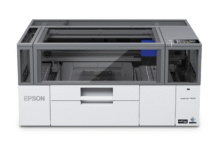
MGI Digital Technology has finally announced the commercial availability of its B1 single-pass inkjet press, the AlphaJet, which was first mooted as a B2 device back in 2012. It has since been reinvented as a complete printing and converting line, mainly aimed at the packaging – though MGI also says that it wants to target commercial printing, books, and magazines.
MGI is best known for producing a range of print-enhancing and finishing machines, many of which make use of inkjet technology. This means that MGI has considerable experience in digitally applying effects such as varnishing and foiling. So it makes perfect sense for the company to develop an inkjet printer that includes all the enhancement and finishing steps in a single process.
And that’s the basic premise behind the AlphaJet, which is essentially a collection of different processes linked via an electromagnetic transport system and arranged in the shape of a horseshoe starting from the feeder stack, going around the different processing stations and ending back up next to the feeder in a take-up stack. The idea is that this will save time in transporting the substrates from one processing line to another and that the cost saving from this will justify the cost of the AlphaJet.
The machine will take sheets up to B1+ or 72 x 110cm, which are carried in 11 smart trays that allow the system to track the individual sheets and apply the desired process to the correct sheets, all while using suction to keep those sheets flat and in registration.
The print unit uses Memjet Duralink printheads and prints in CMYK with Memjet’s water-based pigment ink. This gives it a maximum resolution of 1600 x 1600 dpi and will cover 90% of the Pantone range. It produces up to 1,800 B1 sheets in an hour.
From the printing stations, the trays then deliver sheets through a series of other processes, which can include spot UV coating, foiling and embossing, and OPV lamination. It’s been designed as a modular system so that other units can be added later, and I believe that inline die cutting and creasing will also be available shortly.
It will take substrates from 135 gsm thickness up to 2mm. They include coated and uncoated papers, folding cartons, e-flute cardboard, and synthetics from B2 to B1+ size. The feeder will take up to 2,400 B1 sheets. It uses a suction system that can handle both flexible and rigid sheets, and it’s directly connected to an automatic loader that places the sheets in the smart trays.
The prints have been certified as being deinkable by Ingede for the CMYK water-based inks, and UV coating foiling, on certain substrates. The AlphaJet has also been certified by Fogra.
It’s designed to work with MGI connect cloud-based platforms for digital proofing validation with a digital value-added sales assistant. There’s a control booth to one side. There are cameras throughout the AlphaJet so that the entire system can be run by a single operator.
Edmond Abergel, chief executive officer of the MGI Group, said, “The MGI AlphaJet offers unlimited opportunities. The single-pass factory 4.0, from printing to finishing using water-based and UV inks, is a breakthrough innovation for the printing and packaging industries. One equipment operator, one press, and one single factory. AlphaJet has been a significant journey from concept to finalization, but I know I speak on behalf of the team in saying we are immensely proud of our achievements as we head toward full commercial production. Our all-in-one concept provides huge flexibility for value-added production from proofing to run-lengths of millions – all at a competitive cost.”
Edmond Abergel, chief executive officer of the MGI Group, said, “The MGI AlphaJet offers unlimited opportunities. The single-pass factory 4.0, from printing to finishing using water-based and UV inks, is a breakthrough innovation for the printing and packaging industries. One equipment operator, one press, and one single factory. AlphaJet has been a significant journey from concept to finalization, but I know I speak on behalf of the team in saying we are immensely proud of our achievements as we head toward full commercial production. Our all-in-one concept provides huge flexibility for value-added production from proofing to run-lengths of millions – all at a competitive cost.”
The AlphaJet has been beta tested at ISRA, which has installed the first of these machines at its base in Romans, France. ISRA operates in the packaging sector and prints cards with or without chips aimed at the retail, transport, authentication, and access control markets.
Jean-Pierre Chauvin, CEO of ISRA, commented, “Today, five main steps are generally required in order to produce our products. MGI AlphaJet will enable us to simplify the production flow and free ourselves from certain printing constraints, without load breakages, without waste, and in a time-efficient manner, with unparalleled productivity that is impossible to achieve using conventional equipment.”
Ultimately the success of the AlphaJet will depend on a combination of its pricing, print quality, and flexibility. Together with Indian Printer and Publisher’s editor Naresh Khanna, I saw a number of sheets that had been produced by ISRA back in May at the Print4All show in Milan. I wrote at the time that the image quality was extremely good.
MGI is part-owned by Konica Minolta, which has opened a dedicated demo centre for the AlphaJet in Paris, France. Konica Minolta is also planning to open a second demo centre at its premises in New York, USA, early next year.
This article first appeared on www.nessancleary.co.uk. Reprinted by permission.















